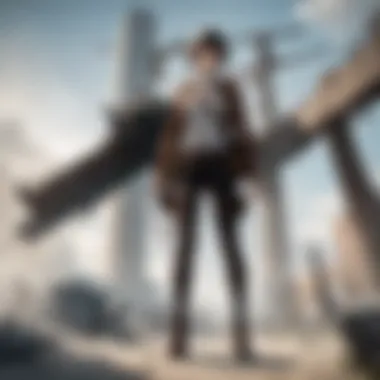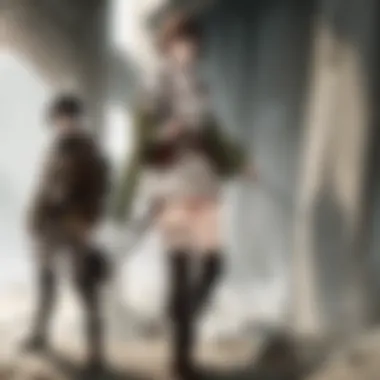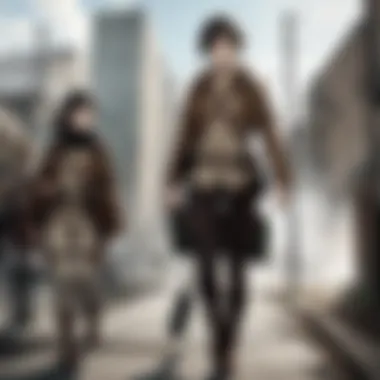Exploring the Seasonal Structure of Attack on Titan


Intro
Attack on Titan has transformed the anime landscape since its debut. This series captivates viewers with its rich story, powerful emotions, and intricate character arcs. The anime adjusts its narrative with each season, leading audiences on a suspenseful journey through twists and plots. As a pioneer in the genre, it blends action with profound themes of humanity, freedom, and survival.
Anime Series Overview
Attack on Titan takes place in a world ravaged by giant humanoid creatures called Titans. The last remnants of humanity reside behind towering walls for protection. The protagonist, Eren Yeager, firmly believes in humanity’s resilience. After a devastating Titan attack leads to personal loss, he vows to eradicate them. The series presents darker themes such as despair and the seeking of freedom. The conflicts within this bottleneck world set a serious tone as it probes into moral ambiguity and existential questions.
Major characters like Mikasa Ackerman and Armin Arlert contribute significantly to its depth. Mikasa epitomizes fierce loyalty, intertwining her fate with Eren's quest. Armin displays intelligence and strategy, alongside a troubled psyche that mirrors deep characterization in antagonistic figures like Reiner Braun and Zeke Yeager.
“Attack on Titan explores not just the fight for freedom, but the complexity of human emotions enveloped in violence and survival.”
With its chaotic yet well-crafted animation style,Attack on Titan also stands out. The rough and aggressive movements of Titans resonate with a pulsating soundtrack composed by Hiroyuki Sawano. Notable episodes such as
Overview of Attack on Titan
The anime series Attack on Titan has emerged as a cultural phenomenon, gripping audiences with its intense narrative and complex characters. In this article, we will dissect its seasonal structure, which is key for understanding its overall impact and storytelling craft. By delineating how each season contributes to the overarching plot and character development, readers will gain insight into the temporal evolution of this masterfully constructed series.
Background of the Series
Attack on Titan began as a manga series written by Hajime Isayama, first published in 2009. The manga became a bestseller, which prompted the adaptation into an anime in 2013. The storyline is set in a dystopian world where humanity is on the brink of extinction due to giant humanoid creatures known as Titans. The aggressive nature of the Titans and the desperate, survival-focused actions of humanity create a palpable tension that has fascinated viewers for years. From the onset, the anime has introduced its themes of oppression, personal struggle, and the quest for freedom.
The development of characters like Eren Yeager and Mikasa Ackerman have tugged at the hearts of many fans, establishing strong emotional undercurrents throughout the series. Events ramp up with violence and strategic battles, each season delving deeper into the lore of the story and unraveling mysteries surrounding the Titans.
Cultural Impact and Popularity
The cultural impact of Attack on Titan is multifaceted and expansive. Primarily, it has influenced a generation of anime fans, revitalizing interest in the medium internationally. The graphically intense scenes juxtaposed with rich storytelling contributed to discussions surrounding freedom and the nature of humanity, which resonated with audiencess on various intelectual levels.
A noteworthy aspect of its popularity is the dedicated fanbase fostered through online platforms such as Reddit and social media hubs like Facebook. Here, fans actively engage in discussions, dissect episodes, and share theories about the narrative's complexities. The language and imagery used in the series have transcended cultures, allowing people from differing backgrounds to connect with its themes.
The show's relevance governing themes such as comradeship, loyalty, and sacrifice also sparks debate beyond just collective viewing experience. Its induction into academia as material for study in philosophy and ethics reflect Attack on Titan's standing in popular culture. The recognition of its global appeal is enforced by numerous awards and accolades throughout its airing, solidifying its influence in contemporary media.
“Attack on Titan has made a significant mark on anime, igniting both interest and discussions involving deep themes”
Seasons Breakdown
The understanding of the seasons of Attack on Titan is fundamental for grasping the evolution of its complex narrative and character arcs. Each season serves not only as a point of continuation but alaso as a departure that reflects growth both in storyline and in thematic depth. By analyzing the seasons, one gains insight into the development of pivotal moments and connections between characters.
Total Number of Seasons
Attack on Titan has a total of four seasons, each contributing uniquely to the overall architecture of the story. The distinction between these seasons can help viewers and readers navigate through various narrative labyrinths effectively. Each one brings its own flavor, potentially influencing viewers' understanding and emotions toward the continuity of the plot.
Season One: Foreword to the World
The first season of Attack on Titan sets the stage for the entire series. Contributors carefully craft its gritty and foreboding atmosphere. Significant themes, such as survival, humanity, and vulnerability, emerge prominently here. Here, Eren Yeager is introduced alongside other central figures such as Mikasa Ackerman and Armin Arlert.
Key points include:
- The Titans, their terrifying nature, and what they represent.
- Core relationships among characters unfold, specifically the bond within the trio.
- Walls Maria, Rose, and Sheena exemplify humanity's desperate attempts to shield themselves from danger.
Understanding the foundation laid in this season is crucial for appreciating the stakes in subsequent storytelling.


Season Two: The Expansion of the Narrative
As Attack on Titan transitions to its second season, the narrative broadens significantly. This season delves deeper negative ecosystem that exists outside humanity's walls, allowing for a richer set of conflicts. Discovery of Titan Shifters adds a new layer of drama indicative of personal struggles and greater stakes.
Points highlighted include:
- Revenge and betrayal arise prominently with characters revealed as Titans.
- More intricacies involving the societal structure begin to emerge.
- Relationships further testedhere through revelations will impact ensuing courses of action and characterization.
Overall, Season Two is where secrets unfold, creating a more complex web of motivations and interactions.
Season Three: A Shift in Tone
In its third season, Attack on Titan experiments with tone significantly, manifesting political undertones and utilitarian dilemmas within the human factions. The split into two parts signifies a change in focus: warring Titans versus schisms within human social structures.
Important developments to note include:
- Exploration of the inner workings of kingdoms, highlighting authority struggles.
- Eren’s motivations are further clarified, emphasizing transformative change through understanding oppression
- The introduction of crucial backstories helps flesh out the significance of earlier characters and their alignment with Eren, Mikasa, and Armin.
The narrative's evolution here showcases the blend of external threat and internal fanout, weaving a dense tapestry of choices and consequences.
Final Season: Concluding the Journey
The Last season brings the expedition to an end wheening march forward culminates in rich characterization, moral complexity, and dutifully harsh revelations throughout. Concepts of justice and vengeance echo triumphantly through character efforts in pace with a frenzied world on fire. Focus turns to results of choices made by characters //heroes who rise against titans both literal and metaphorical.
Highlights from this season feature:
- Character invaluable moments, where Eren's decisions bear immense weight.
- A panoramic look at consequences that affect human civilization moving forward.
- Expansion beyond established narratives into overhaul questions challenging ideas worth tackling like glory and its cost.
As a capstone, the final season endeavors to tie together many dangling participles present, offering resolution but at a hefty price.
Release Dates and Patterns
The exploration of Release Dates and Patterns is essential in understanding how Attack on Titan has captured audience attention over time. Each season's rollout influences viewership and discussions within the anime community. By examining these release patterns, one gains insight into the production quality and audience expectations. This allows fans to better appreciate the effort involved in making this series iconic.
Season One Release Timeline
Season One of Attack on Titan premiered on April 7, 2013. This initial release consisted of 25 episodes and concluded on September 28, 2013. The anticipation prior to the first episode had built significantly, thanks to the manga's growing popularity. Viewers were eager to see how the complex storyline and richly developed characters would translate to animation.
On several platforms, enthusiasts often revisited the premiere date, confirming its significance in shaping the show's trajectory. The combination of thrilling plot twists and production quality set a high standard right from the beginning.
Subsequent Seasons' Release Intervals
Following the first season, each subsequent season was launched with varying intervals. Notably, there exists a discernible trend of longer gaps in between seasons towards the later entries. Here’s a brief overview:
- Season Two: April 1, 2017 – 12 episodes
- Season Three (Part 1): June 23, 2018 – 12 episodes
- Season Three (Part 2): April 9, 2019 – 10 episodes
- Final Season (Part 1): December 7, 2020 – 16 episodes
- Final Season (Part 2): January 9, 2022 – 12 episodes
- Final Season (Part 3): set for 2023.
This gradual expression of content illustrates that creative depth often requires more time to cultivate rich storytelling. Fans have learned to expect a blend of artistry and thoughtfulness in each new installment. Moreover, these release intervals facilitated extensive online discourse and anticipation among viewers.
Factors Influencing Release Schedules
Several elements dictate the release schedules for Attack on Titan. First, production quality plays a crucial role. The level of detail in animation and story development needs time for refinement. Creators also juggle multiple aspects, including voice acting, sound design, and action choreography.


Second, marketing strategies cannot be overlooked. A well-timed release can maximize viewer engagement and media coverage, ensuring the show retains its cultural relevance. Additionally, generating a buzz around a season's release contributes to sustaining high anticipation levels.
Lastly, workload and staffing within the production house indicate timelines. Shifts in workforce or unexpected delays can result in longer gaps between seasons. However, careful planning helps balance quality and delivery, ensuring that Attack on Titan maintains its distinguished reputation.
Character Development Across Seasons
Character development is a central theme in Attack on Titan. Understanding how characters evolve through different seasons enhances one’s appreciation of both their struggles and their triumphs. This process reflects not only personal growth but also the transformations brought on by harsh realities of their world. Each character reveals a unique depth as they face adversities and make choices that lead to significant changes. The narrative threads of these characters are interwoven with the overarching themes of freedom, oppression, betrayal, and sacrifice, giving viewers ample material to engage with and analyze.
Eren Yeager's Transformation
Eren Yeager's character is at the core of Attack on Titan. From the beginning, he is portrayed as a passionate young man driven by a desire for freedom. However, as the distinctions between morals and survival blur throughout the seasons, Eren’s transformation becomes more complex.
In the first season, he is an impulsive child fighting for his friends and family. But as he encounters betrayals and the grim realities of living in a walled world, his naivety transforms into determination and drive.
By the mid-seasons, Eren evolves into a more calculated figure, embracing tactics necessary for fighting titans and now, enemies among his own kind. Sophisticated elements such as his acceptance of hard decisions add layers to his personality. Here, viewers can notice the meaning of freedom, and how it shifts for him as testimonies pile up against the cost his prior attempts bear. In the final act, audiences are faced with a conflicted figure—one who seems almost tragic, embodying the very cycles he initially sought to break.
Mikasa Ackerman’s Role
Mikasa Ackerman serves not just as Eren's protector but also evolves as an independent and formidable character in her own right. Her fierce loyalty stems from traumatic early experiences, setting a foundation for her development across the seasons.
In the earlier stages of the series, Mikasa relentlessly defends Eren with her exceptional skills. However, it becomes apparent that her loyalty often teeters on obsession. Progressively, Mikasa asks critical questions about her own feelings and decisions. These reflections signify her transition from merely being a supporting character to one with agency. The internal struggle she undergoes, especially regarding her relationships with Eren and Armin, illustrates the challenges of loyalty and identity.
As the narrative unfolds, Mikasa confronts her own desires versus her obligations, forcing viewers to witness not only her growth but also the cumulative impact of her love on decisions she must make. This complexity makes Mikasa a beacon of emotional intelligence in the series.
Levi Ackerman and Leadership
Levi Ackerman exemplifies leadership through chaos and despair within Attack on Titan. His journey paints a nuanced portrait of what it means to be a leader in desperate times. Not only does he possess overwhelming physical prowess, but his character also embodies a shrewd strategic mind.
From the beginning, Levi's cold demeanor causes viewers to question his motivations. However, in formative conflicts, his leadership styles become evident. Rather than relying solely on his strengths, Levi values the lives of those around him and demonstrates the burden of responsibility. His relationship with his squad reveals significant characteristics of mentorship as he shares lessons of resilience and perseverance.
Over time, challenges force him to question his own beliefs. As situations escalate, Levi's decisions become more impactful and often burdened, providing different perspectives on agency as a leader. The audience sees a man wrestling with his emotions: guilt, camaraderie, duty. Each encounter enhances viewers' understanding of his character, emphasizing becoming a leader amid him grappling with his open admiration for humanity, often amidst severe losses.
The intricate growth of each character contributes not only to the storytelling but also serves as a mirror to the complexities of human nature in facing dire circumstances.
Themes and Motifs
Themes and motifs serve as the underpinning structure of Attack on Titan, enriching the narrative and providing depth to character arcs and storylines. These elements allow viewers to draw parallels with real-world situations, enhancing the utility of the animation as a vessel for commentary on significant themes. Furthermore, engaging with these core ideas can lead to a deeper understanding of the series as well as elevate the viewing experience for its audience.
Freedom versus Oppression
The theme of freedom versus oppression is at the forefront of Attack on Titan, serving as a fundamental conflict throughout the series. Characters grapple with the concept of confinement and the longing for liberty, often illuminated through the pain felt due to restrictions imposed by Titans and controlling governments alike. For Eren Yeager, seeking freedom is a driving force, as his evolution drives he and his friends to challenge the very structures that bind them. The stark representation of liberation versus domination raises critical philosophical questions diectly relating to human endurance in the face of insurmountable challenges.
Friendship and Betrayal
Next, friendship and betrayal spiral into the narrative, portraying the complexity of human relations amid turmoil. Initial bonds formed between characters evolve as they confront external threats and the harsh realities of their world. The narrative centrally questions the integrity of friendships when survival instincts take precedence. Historic betrayals—such as those informally orchestrated by characters like Reiner and Bertholdt—cast a shadow upon at first seemingly unwavering loyalties. Each encounter leads to a more nuanced perspective on trust in high-stake environments, forcing characters and viewers alike to grapple with how individual needs sometimes clash with cherished connections.
Survival and Sacrifice
Lastly, survival and sacrifice delineate the emotional fabric of Attack on Titan. Characters are repeatedly forced to make earth-shattering decisions that weigh personal wellbeing against that of their comrades or even wider society. The burdens of survival extract costs undeniable through actions taken to protect the few ones left alive. This extensively addresses existential concerns and resonates densely throughout both the flesh of the story and its viewers.
“Sometimes, it is necessary to say goodbye to yesterday in order to move on.”


In summary, the motifs of freedom versus oppression, friendship and betrayal, and survival and sacrifice encapsulate the struggles and moments of triumph experienced throughout Attack on Titan. These themes afford analytical depth while providing ample room for profound interpretations by the audience. Consequently, thematics foster an emotional connection, guiding viewers through the maze of relationships, conflicts, and moral dilemmas buried deep within the series.
Artistic and Technical Aspects
The artistic and technical components in Attack on Titan play a vital role in transmitting the series’ core themes and emotions. These elements transcend mere aesthetic value, embedding deeper narrative meanings that enrich the viewing experience. By examining the visual storytelling and audio design, we uncover how these aspects accentuate the overall impact of the series. This section delves into two crucial dimensions: animation style and soundtrack. Both elements, while distinct, work together to craft an engrossing world.
Animation Style and Impact
Attack on Titan is lauded for its stunning animation. Produced by Wit Studio for the first three seasons and later by MAPPA, the animation packs a punch, providing fluid movements that mirror the tense atmosphere. The use of 3D maneuver gear has been a high point; it is not just technically impressive but also enhances the storytelling. The way characters move gracefully through a chaotic environment symbolizes their struggle against oppression.
Additionally, the artistic decisions in character design contribute to their complexity. The characters wear expressions that reflect both their inner turmoil and the large-scale horrors unleashed by the Titans. For instance, Eren Yeager's progression from naive to resolute hero is visually represented through changing aesthetics. The contrasting art style when depicting idyllic scenes against the gruesome reality of Titan attacks serves to deepen viewer investment, often eliciting strong emotional reactions.
Overall, the animation style not only promotes the narrative’s urgency but also transforms individual character arcs into an embroidering tapestry of human experience. The artistry instigates viewers to form robust connections with characters and their journeys.
Soundtrack and Its Role
The soundtrack of Attack on Titan is equally important in adding layers to the viewing experience. Composed primarily by Hiroyuki Sawano, the music marries orchestral compositions with electronic elements, creating an extraordinary sound landscape. This blend amplifies the tension during thunderous battle sequences and injects a poignant depth into quieter moments. Tracks like **
Reception and Critique
The reception and critique of Attack on Titan emphasize the anime's influence and the multifaceted opinions from both critics and viewers. Analyzing this section is vital to appreciate how the series resonates with its audience and the anime community. Understanding the reactions helps soften perspectives on both favorability and misunderstandings around themes presented in the series. A comprehensive view of reception adds layers to how one perceives narratives in the context of anime today.
Critical Acclaim
Attack on Titan has garnered formidable acclaim from both critics and fans around the world. Its strong narrative combined with dynamic character arcs justifies its status in anime canon. Critics have often resonated with its approach to story pacing and the depth of its characters. Especially in seasons that delve into moral ambiguities, such as the later parts of the story, reviews regularly highlight the bold themes challenging traditional narratives in anime.
Important magazines and websites, including MyAnimeList and Crunchyroll, have acknowledged its artistic merits and elaborate storytelling. Its animation, led by Wit Studio, sets high standards in the industry, engaging viewers with both visual impact and emotional depth.
Moreover, particular episodes are frequently cited in critiques for their compelling execution of plot twists and dramatic conflicts, which elevate the storytelling experience. The reception thus reflects a significant appreciation of the series as not merely entertainment but as a thought-provoking work.
Audience Reception
Audience reception of Attack on Titan is remarkably diverse. While many fans demonstrate loyalty to characters and plot trajectories, the series experiences varying opinions across different fan bases. Specifically, forums like Reddit shine a spotlight on these discussions, often capturing both admiration and criticism regarding character decisions and world-building.
Some viewers champion Attack on Titan for its intense exploration of themes like freedom and oppression. They find the ethical quandaries throughout the series deeply engaging. Other fans might critique the pacing and the controversial arcs that involve betrayal or unexpected character changes.
Overall, community reception reflects a mix of impassioned debates and informed discussions, which ultimately contribute to the series' ongoing relevance in contemporary anime culture. It draws attention from extensive online reviews to rigorous analysis within academic circles, making it a multidimensional work worth investigating further.
Future of Attack on Titan
The future of Attack on Titan holds significance for both the existing fan base and newcomers. With its vast narrative universe and complex character arcs, there are constant discussions about how to extend the rich story beyond the concluding events of the anime. Fans frequently speculate about potential spin-offs and other adaptations. These conversations create anticipation and consistently renew interest in the series long after its initial run.
Possible Spin-offs and Continuations
Many fans are curious about potential spin-offs that could arise following the finale. The protagonist, Eren Yeager, and characters like Mikasa and Armin could see their stories explored further. The stories could delve into their lives post the series events, highlighting how they adapt in a world with greater freedom yet plagued with new struggles.
- Eldian History: Following the Eldian race could present a compelling angle to unveil historical narratives that shaped their path. Such a spin-off might educate viewers on how Eldians saw the world and each other before the anime events.
- Other Nations: There is also a possibility to explore civilizations outside of Eren's island. By focussing on the Saviors of Marley or other factions, the narrative may develop rich new storylines while expanding the series' geopolitical scope.
- Character-Focused Series: Perhaps, individual character arcs like Levi's or Pieck's journey throughout the conflicts might represent great content. Examining their internal battles against visible enemies provides layers that can gather fresh viewers.
These projected spin-offs highlight the deep desire for more from the Attack on Titan universe and could effectively create opportunities for character growth and narrative complexity.
Potential for Future Adaptations
Adaptations towards other media types hold a prominent place in the future outlook. With Attack on Titan's success originating from manga, transitioning into novels, video games, or even live-action interpretations feels promising. Exploring why adaptations matter expands further than mere franchise growth; they build a versatile storytelling legacy:
- Graphic Novels: Adapting narrative arcs into new illustrated novels can provide an insightful look into character psychologies, otherwise less intricate in the anime format.
- Video Games: There is considerable potential for immersive gaming experiences taking place in the Attack on Titan universe where players can enact battles. Players could have choices affecting relationships among characters.
- Live Action Films or Series: Expanding into live action is complex, but if done right, it might boost Attack on Titan's narrative depth. Careful commitment to authenticity while appealing to a broader audience can rekindle excitement.
Overall, the future seen for Attack on Titan suggests expansive possibilities for storytelling, creating happier collaborators in several mediums, offering fans even more thoughtful additions to this legendary saga.
“The world of Attack on Titan is limitless when it comes to exploration.”
Looking at what lies ahead, Attack on Titan stands as a story birthed from deep personal conflicts and external battles. As manga and the quality storytelling continues in isolated and standing alone versions, dedicated fans and curious viewers are destined for memorable experiences that revolve around long-standing themes within new contexts.







